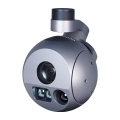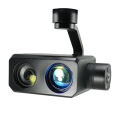Solutions for mountain rescue
Our drone solutions can be used to quickly map mountain rescue areas. Using maps, images and video, mountain rescue units can get a detailed picture of the scene while keeping rescuers safe.
Key benefits for rescue units
Search and rescue
Effectively scanning vast mountain areas and locating missing persons with high-resolution digital and thermal cameras.
- Rescue missions involve inherent risks for rescuers, which can be intensified by incomplete information about the situation.
- Rescue teams can be dispersed when target areas are extensive and the terrain challenging.
- Night-time and poor lighting makes searching difficult, which greatly complicates rescue missions.
Drones support search and rescue
- Scanning vast areas and identifying risks to victims and rescuers using high-resolution aerial photography.
- Raise the perspective of responders and take search and rescue to a new level of efficiency.
- At night or in low-light conditions, use thermal sensors to locate missing persons who might otherwise be overlooked.
Responding to catastrophes
Flights over disaster areas, e.g. after an avalanche, documenting damage to infrastructure and property and optimising relief efforts.
- In the event of a disaster, when every moment matters, the complex terrain and environment can delay response times.
- The affected areas endanger victims and rescue teams, which can be exacerbated by a lack of clear information and communication.
- Aid activities and priority setting can be complicated by an incomplete perspective of the affected area.
Drones help with catastrophe response
- Flying over obstacles and hazards, immediately gaining perspective and starting to provide assistance.
- An aerial view can help direct ground teams, facilitate communication and synchronise rescue efforts.
- Quick 2D and 3D modelling of the affected areas can produce maps that will help guide relief efforts in the future.
Mission situational awareness
It provides operations commanders with an accurate, real-time view of the mission, enabling them to make confident decisions. Use our Prometheus H2 Hybrid Drone Platform, equipped with professional cameras and thermal sensors, to respond more effectively in emergency situations, helping rescuers to take the lead through better situational awareness.
- Without comprehensive mission data, ground teams struggle with blind spots and are exposed to unnecessary risks.
- Insufficient situational awareness hinders the effective allocation of resources to maximise safety and minimise response time.
Drones increase mission situational awareness
- The drone allows you to get to the scene quickly and gain immediate aerial insight.
- Hovering over the unfolding mission and sending live updates directly to the command centres.
- Synchronisation of teams, elimination of uncertainty and certainty in decision-making.
Maintaining a safe distance
It is important to quickly and efficiently contain the scene of a disaster or other mass casualty event. Gathering intelligence on the terrain and movements of people is key to minimising risk while maximising the safety of the emergency services.
Drones increase the effectiveness
Aerial imaging using the Prometheus H2 HPD with dedicated accessories can help identify the location of people and property and then assess the level of risk if the scene needs to be scanned from a distance for security or tactical reasons.
During an operation, there is a lot of critical information that can be combined using imagery and data from a drone. For example, identifying the presence of civilians in an area, the exact location of people and how vulnerable they are – or even spotting an evacuation route or vehicles nearby.
Such information enhances the operational effectiveness of mountain rescue and services cooperating with it.
Drones increase the effectiveness
of mountain rescue units
Aerial imaging using the Prometheus H2 HPD with dedicated accessories can help identify the location of people and property and then assess the level of risk if the scene needs to be scanned from a distance for security or tactical reasons.
During an operation, there is a lot of critical information that can be combined using imagery and data from a drone. For example, identifying the presence of civilians in an area, the exact location of people and how vulnerable they are – or even spotting an evacuation route or vehicles nearby.
Such information enhances the operational effectiveness of mountain rescue and services cooperating with it.
Hybrid drone platform 
Dedicated accessories
for the Protector model
Similar solutions for rescue industry


Follow us
Contact
-
+48 797 476 054
-
Al.Krakowska 110/114
budynek B-27
02-256 Warszawa








